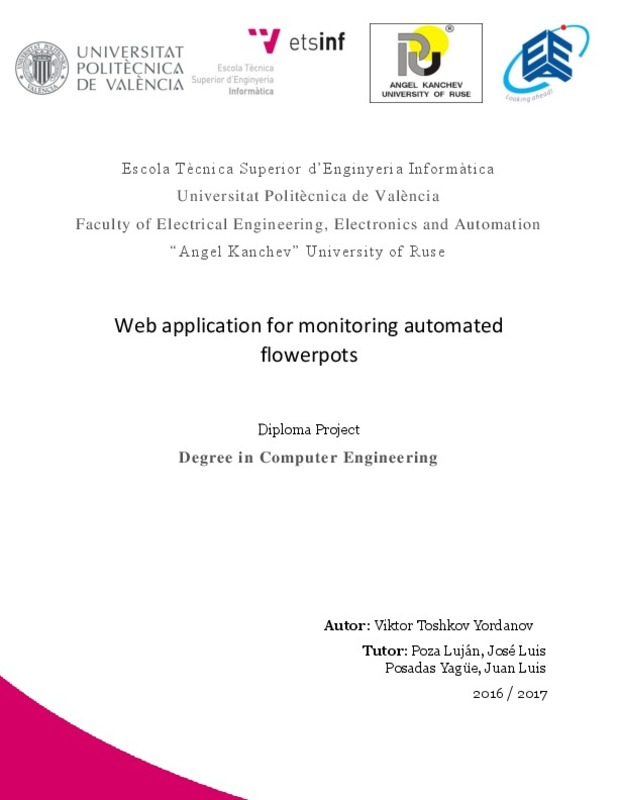JavaScript is disabled for your browser. Some features of this site may not work without it.
Buscar en RiuNet
Listar
Mi cuenta
Estadísticas
Ayuda RiuNet
Admin. UPV
Web application for monitoring automated flowerpots
Mostrar el registro sencillo del ítem
Ficheros en el ítem
| dc.contributor.advisor | Poza Luján, José Luis
|
es_ES |
| dc.contributor.advisor | Posadas Yagüe, Juan Luís
|
es_ES |
| dc.contributor.author | Toshkov Yordanov, Viktor
|
es_ES |
| dc.date.accessioned | 2017-09-11T08:40:07Z | |
| dc.date.available | 2017-09-11T08:40:07Z | |
| dc.date.created | 2017-07-20 | |
| dc.date.issued | 2017-09-11 | es_ES |
| dc.identifier.uri | http://hdl.handle.net/10251/86927 | |
| dc.description.abstract | [EN] Nowadays, caring for your plants (that grow in gardens or flowerpots) has become more difficult and this can lead to slowing the growing process or even death of the plant. In order to help for the prevention of this problem so far has been created several devices which offer full control and automatization and can take care of your plants for you. Those systems however need to be managed easily as well as remotely. The usefulness of the mobile phones is well proven over the years and is one of the best solutions for the problem with the management of the automated systems. Developing a mobile application and making it user-friendly is a long process, but surely provides a great solution to the problem. The main purpose of the current work was to create a prototype of a mobile application for remote monitoring and control of those automated systems. In order to carry out this project, a research of similar systems have been done and from them the functionalities that are desired for the application have been extracted. All of them were described using Use-Case diagrams and tables. For the design of the application it was chosen to use the ThreeLayer architecture, because it is a part of another bigger project done by other students and this way it would provide bigger flexibility, but later it was developed using the MVC architecture in a local environment. The main goal of this project was to offer a way to visualize the data coming from the chombos, also a way to move it. Another objective that was achieved is to make the design of the application user-friendly and lightweight as well as responsive to be able to run on different devices. Most of the functionalities that were described are only visually implemented, but not functional, while only some of them were fully implemented to make the application feel alive. | es_ES |
| dc.description.abstract | [ES] Actualmente, el cuidado de las plantas domésticas (que crecen en jardines o en macetas) es complicado para mucha gente, lo cual puede ocasionar un crecimiento más lento de las plantas o incluso que mueran. Para ayudar a prevenir este problema, se han creado dispositivos que ofrecen un control total y automático para el cuidado de las plantas. Sin embargo, estos sistemas necesitan ser gestionados fácilmente y de modo remoto. En los últimos años se ha demostrado la versatilidad de los teléfonos móviles, de modo que están siendo una de las mejores soluciones para el problema de manejar sistemas automáticos. El desarrollo de una aplicación web que sea fácil de usar es un proceso complejo, pero sin duda proporciona una solución adecuada al problema planteado. El propósito principal del trabajo actual fue crear un prototipo de una aplicación móvil para el monitoreo y control remoto de esos sistemas automatizados. Para llevar a cabo este proyecto, se ha realizado una investigación de sistemas similares y de ellos se han extraído las funcionalidades que se desean para la aplicación. Todos ellos se describieron utilizando diagramas de casos de uso y tablas. Para el diseño de la aplicación se optó por utilizar la arquitectura Tres Capas, ya que es parte de otro proyecto más grande realizado por otros estudiantes y de esta manera se obtendría una mayor flexibilidad, pero más tarde se desarrolló utilizando la arquitectura MVC en un entorno local. El objetivo principal de este proyecto era ofrecer una forma de visualizar los datos procedentes de los chombos, también una forma de moverlo. Otro objetivo que se logró es hacer que el diseño de la aplicación sea fácil de usar y ligero, además de responder a la posibilidad de ejecutar en diferentes dispositivos. La mayoría de las funcionalidades que se describieron sólo se implementan visualmente, pero no son funcionales, mientras que sólo algunas de ellas se implementaron completamente para que la aplicación se sintiera viva. | es_ES |
| dc.format.extent | 63 | es_ES |
| dc.language | Inglés | es_ES |
| dc.publisher | Universitat Politècnica de València | es_ES |
| dc.rights | Reconocimiento (by) | es_ES |
| dc.subject | System automation. Monitoring | es_ES |
| dc.subject | Web | es_ES |
| dc.subject | Flowerpots | es_ES |
| dc.subject | Macetas | es_ES |
| dc.subject | Sistema automático. Monitorización | es_ES |
| dc.subject.classification | ARQUITECTURA Y TECNOLOGIA DE COMPUTADORES | es_ES |
| dc.subject.other | Grado en Ingeniería Informática-Grau en Enginyeria Informàtica | es_ES |
| dc.title | Web application for monitoring automated flowerpots | es_ES |
| dc.type | Proyecto/Trabajo fin de carrera/grado | es_ES |
| dc.rights.accessRights | Abierto | es_ES |
| dc.contributor.affiliation | Universitat Politècnica de València. Escola Tècnica Superior d'Enginyeria Informàtica | es_ES |
| dc.contributor.affiliation | Universitat Politècnica de València. Departamento de Informática de Sistemas y Computadores - Departament d'Informàtica de Sistemes i Computadors | es_ES |
| dc.description.bibliographicCitation | Toshkov Yordanov, V. (2017). Web application for monitoring automated flowerpots. http://hdl.handle.net/10251/86927. | es_ES |
| dc.description.accrualMethod | TFGM | es_ES |
| dc.relation.pasarela | TFGM\71970 | es_ES |
Este ítem aparece en la(s) siguiente(s) colección(ones)
-
ETSINF - Trabajos académicos [5160]
Escola Tècnica Superior d'Enginyeria Informàtica






